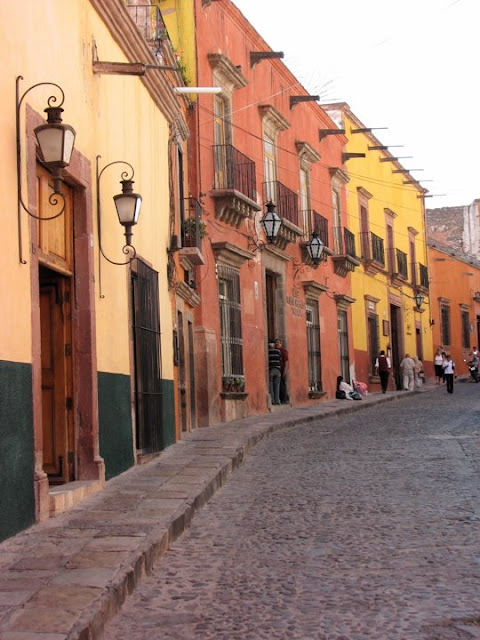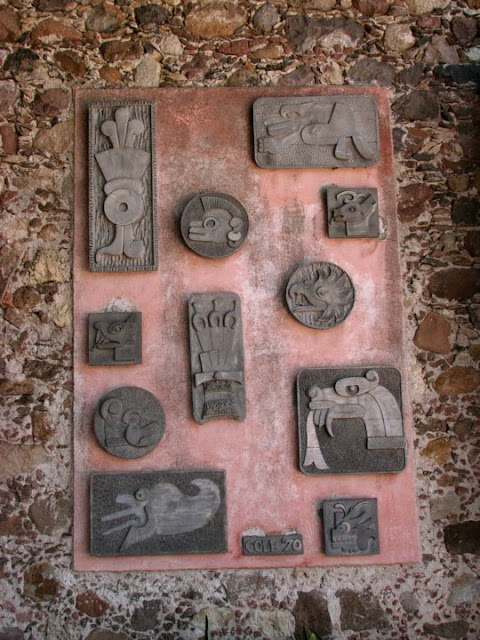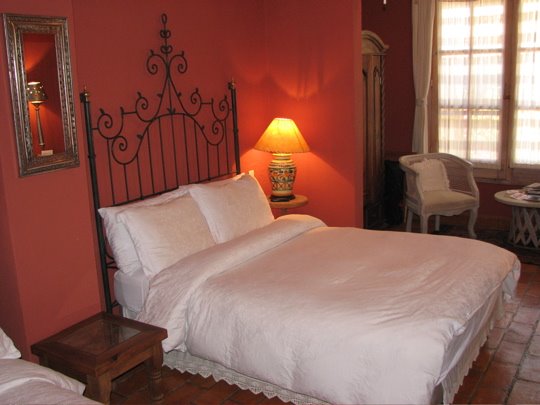 Templo del Oratorio welcomes the sunrise. There is much more to San Miguel Allende’s religious architecture than the great Parrochia church for which the town is known (see part 3 of this series). Sometimes it seems there is a beautiful religious structure around every corner. I took this shot at sunrise from the mirador (roof garden) of the Casa Calderoni B&B where we stayed (see part 1). The soft morning rays gradually lit up the splendor of the steeples, domes and turrets of the Templo del Oratorio, Templo de Nuestra Senora de la Salud, and the Ex-Convento de San Francisco de Sales.
Templo del Oratorio welcomes the sunrise. There is much more to San Miguel Allende’s religious architecture than the great Parrochia church for which the town is known (see part 3 of this series). Sometimes it seems there is a beautiful religious structure around every corner. I took this shot at sunrise from the mirador (roof garden) of the Casa Calderoni B&B where we stayed (see part 1). The soft morning rays gradually lit up the splendor of the steeples, domes and turrets of the Templo del Oratorio, Templo de Nuestra Senora de la Salud, and the Ex-Convento de San Francisco de Sales. Quiet devotion. Many Mexicans, particularly among the poor, are deeply religious. I found this elderly Indio woman seated on the floor in a dark corner of Templo de San Francisco, quietly and fervently praying. Surrounded by the opulent splendor of the church, it is likely she owned little more than she was wearing. This is Carole's favorite picture of mine. She thinks it has the feel of a painting. The corner was very dark and, since I couldn't use a flash in the church, I had to greatly increase the exposure to create this effect.
Quiet devotion. Many Mexicans, particularly among the poor, are deeply religious. I found this elderly Indio woman seated on the floor in a dark corner of Templo de San Francisco, quietly and fervently praying. Surrounded by the opulent splendor of the church, it is likely she owned little more than she was wearing. This is Carole's favorite picture of mine. She thinks it has the feel of a painting. The corner was very dark and, since I couldn't use a flash in the church, I had to greatly increase the exposure to create this effect. Templo de la Immaculada Concepcion from the Centro Cultural courtyard. The dome of the Templo (also called Las Monjas) is seen here looming above the lush courtyard of the Centro Cultural Ignacio Ramirez, itself a former convent now turned into a center for music and the arts.
Templo de la Immaculada Concepcion from the Centro Cultural courtyard. The dome of the Templo (also called Las Monjas) is seen here looming above the lush courtyard of the Centro Cultural Ignacio Ramirez, itself a former convent now turned into a center for music and the arts. Los Monjas dome interior. I took this shot looking straight up at the interior of the dome of Los Monjas, which gives the impression of an immense mandala. The spidery looking object in the middle is the crystal chandelier suspended from the peak of the dome. The craftsman who built this dome created the illusion that the dome is higher than it actually is by using smaller bricks as he approached the peak.
Los Monjas dome interior. I took this shot looking straight up at the interior of the dome of Los Monjas, which gives the impression of an immense mandala. The spidery looking object in the middle is the crystal chandelier suspended from the peak of the dome. The craftsman who built this dome created the illusion that the dome is higher than it actually is by using smaller bricks as he approached the peak. Los Monjas corner detail. Painted on each corner of the mandala dome is a religious scene. As is often the case, only by mounting a tall ladder or possessing a telephoto lens can one appreciate the full beauty and detail of the paintings set in the forks between the graceful arches supporting the dome.
Los Monjas corner detail. Painted on each corner of the mandala dome is a religious scene. As is often the case, only by mounting a tall ladder or possessing a telephoto lens can one appreciate the full beauty and detail of the paintings set in the forks between the graceful arches supporting the dome. Sunrise over Templo de San Francisco. Seen from the roof garden of our B&B, the dome of the Templo de San Francisco rises above tall battlements which themselves rise approximately 60 ft. vertically from the street, giving the church a castle-like appearance.
Sunrise over Templo de San Francisco. Seen from the roof garden of our B&B, the dome of the Templo de San Francisco rises above tall battlements which themselves rise approximately 60 ft. vertically from the street, giving the church a castle-like appearance. Madly ornate. The façade surrounding the entrance of the Templo de San Francisco was built in an artistic style called Churrigueresque. Extremely elaborate, almost exploding with minutely detailed figures and designs, this style was popular in late 1600s to mid-1700s Spanish Mexico. However, it was very expensive and Church leaders could only afford to complete the façade in this manner, giving a stark contrast to the huge walls of plain stone surrounding it.
Madly ornate. The façade surrounding the entrance of the Templo de San Francisco was built in an artistic style called Churrigueresque. Extremely elaborate, almost exploding with minutely detailed figures and designs, this style was popular in late 1600s to mid-1700s Spanish Mexico. However, it was very expensive and Church leaders could only afford to complete the façade in this manner, giving a stark contrast to the huge walls of plain stone surrounding it.Jardin Botanico preserves lovely high desert plants
 Just landed from Mars? Looking like some exotic, multi-tentacled monster, this cactus plant is native to the high desert region of the Bajio plateau overlooking San Miguel. The Jardin Botanico, located at the top of the bluffs overlooking San Miguel, turned out to be much larger than we had expected. A trail looping through it took three hours at a leisurely pace, with occasional stops for photos. And that was only one of the trails! We have been pleasantly surprised that Mexico seems to be increasingly interested in preserving its natural heritage as well as its historical heritage.
Just landed from Mars? Looking like some exotic, multi-tentacled monster, this cactus plant is native to the high desert region of the Bajio plateau overlooking San Miguel. The Jardin Botanico, located at the top of the bluffs overlooking San Miguel, turned out to be much larger than we had expected. A trail looping through it took three hours at a leisurely pace, with occasional stops for photos. And that was only one of the trails! We have been pleasantly surprised that Mexico seems to be increasingly interested in preserving its natural heritage as well as its historical heritage. Under construction: wetlands and island. In this photo you can see the rolling high desert country on the plateau behind San Miguel. In the middle ground is a wetland, mostly mud at the moment as the seasonal rains approach. This will become a shallow lake in a few weeks. The circular dark mounds topped with vegetation are man-made islands. The hope is that this will attract birds that will then begin to restore more of the ecosystem as they spread seeds with their droppings.
Under construction: wetlands and island. In this photo you can see the rolling high desert country on the plateau behind San Miguel. In the middle ground is a wetland, mostly mud at the moment as the seasonal rains approach. This will become a shallow lake in a few weeks. The circular dark mounds topped with vegetation are man-made islands. The hope is that this will attract birds that will then begin to restore more of the ecosystem as they spread seeds with their droppings. Water power through the ages. The Spanish constructed the original dam to catch water for their town below. The dam sits at one end of the wetland, just where the gorge begins to drop through the bluffs above San Miguel. In the 19th Century, the Fabrica Aurora textile company built a factory just where the gorge opens up to the town, and piped water from this dam down the length of the gorge to power their mill. Rusting sections of this old pipe can still be found. When the summer rains come, the dam turns the wetlands into a shallow lake
Water power through the ages. The Spanish constructed the original dam to catch water for their town below. The dam sits at one end of the wetland, just where the gorge begins to drop through the bluffs above San Miguel. In the 19th Century, the Fabrica Aurora textile company built a factory just where the gorge opens up to the town, and piped water from this dam down the length of the gorge to power their mill. Rusting sections of this old pipe can still be found. When the summer rains come, the dam turns the wetlands into a shallow lake Cactus flower. If one looks closely, the desert in this area abounds with flowers. This lovely bud was just opening on the tip of a cactus plant.
Cactus flower. If one looks closely, the desert in this area abounds with flowers. This lovely bud was just opening on the tip of a cactus plant. Caution! Look, but touch at your own risk. This pair of multi-colored barrel cactus contrasted nicely with the cool, lily pad-covered pond next to them. The amount of color and wonderful textures in the high desert always amazes me, making it one of my favorite types of country to visit.
Caution! Look, but touch at your own risk. This pair of multi-colored barrel cactus contrasted nicely with the cool, lily pad-covered pond next to them. The amount of color and wonderful textures in the high desert always amazes me, making it one of my favorite types of country to visit. Desert flower with bee. As we looked down from high above at the muddy wetland, I noticed what I thought were white birds feeding in the mud. As we got closer I found it odd that they didn’t move. Finally, I realized they were large, beautiful, white flowers with delicate purple veins. An industrious bee was busily pollinating this one.
Desert flower with bee. As we looked down from high above at the muddy wetland, I noticed what I thought were white birds feeding in the mud. As we got closer I found it odd that they didn’t move. Finally, I realized they were large, beautiful, white flowers with delicate purple veins. An industrious bee was busily pollinating this one. Sun Worshipers. These cacti seem to be raising their arms to welcome the rays of the early morning sun. We picked a good time to visit, about 9:00 am, and encountered almost no other visitors. In addition, the golden morning light and cool air were ideal for strolling several miles of the nature paths.
Sun Worshipers. These cacti seem to be raising their arms to welcome the rays of the early morning sun. We picked a good time to visit, about 9:00 am, and encountered almost no other visitors. In addition, the golden morning light and cool air were ideal for strolling several miles of the nature paths. Plaza of the Four Winds. Located on a rise overlooking the gorge that bisects the botanical garden, this plaza offers a mixture of Indio and Catholic religious symbols. Intricately designed plazas go far back into Mexico's history. The plaza was very quiet when we visited, with only the wind and the occasion buzz of a curious hummingbird breaking the silence.
Plaza of the Four Winds. Located on a rise overlooking the gorge that bisects the botanical garden, this plaza offers a mixture of Indio and Catholic religious symbols. Intricately designed plazas go far back into Mexico's history. The plaza was very quiet when we visited, with only the wind and the occasion buzz of a curious hummingbird breaking the silence.This completes our four part series on our visit to San Miguel Allende. The number of visitors these four posts received over the last month indicates that our new strategy of shortening the posts was successful. Thanks for coming along with us to enjoy San Miguel de Allende. If you have time, please take the opportunity to visit other pages in our archives!
Hasta luego! Jim & Carole








































